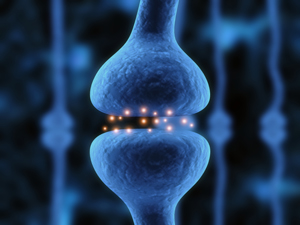Sep. 26, 2014 Research Highlight Biology
Protein pairing builds brain networks
A specific protein interaction is crucial for building networks in the brain and may be important in some neurological disorders
 Figure 1: Neurons communicate across small gaps called synapses. The protein mGluR7 is found in the membrane of the presynaptic neuron and the protein Elfn1 is found in the opposite postsynaptic membrane. © Sebastian Kaulitzki/Hemera/Thinkstock
Figure 1: Neurons communicate across small gaps called synapses. The protein mGluR7 is found in the membrane of the presynaptic neuron and the protein Elfn1 is found in the opposite postsynaptic membrane. © Sebastian Kaulitzki/Hemera/Thinkstock
Neural networks are formed by the interconnection of specific neurons in the brain. The molecular mechanisms involved in creating these connections, however, have so far eluded scientists. Research led by Jun Aruga from the RIKEN Brain Science Institute has now identified an interaction between two proteins that is crucial for making connections between specific types of neurons, with implications for some neurological disorders1.
Connections between neurons are made via synapses—small gaps across which chemicals called neurotransmitters pass, relaying signals from a presynaptic neuron to a postsynaptic neuron. Aruga and his colleagues focused on a protein called mGluR7, which is found only at synapses with a specific type of postsynaptic neuron in an area of the brain involved in forming memories.
“mGluR7 is located on the presynaptic side of connections made with hippocampal local inhibitory neurons,” explains Aruga. “Previous studies have proposed that this protein prevents neurotransmitter release from the presynaptic neuron when the neurotransmitter glutamate binds to it.”
The researchers discovered that the localization of mGluR7 to specific synapses is determined by the presence of another protein called Elfn1. This protein is found on the other side of the same synapses, directly opposite mGluR7. When the researchers artificially introduced Elfn1 into cultured cells, mGluR7 became associated with the same cells, and they showed that this was due to a physical interaction between the two proteins. Conversely, deleting Elfn1 in the brains of mice reduced the amount of mGluR7 at the synapses.
These changes interfered with the process of strengthening connections at synapses, which takes place during memory formation, and caused patterns of brain waves that indicated abnormally high levels of electrical activity. Genetically altered mice also exhibited other symptoms that resembled human conditions.
“Deleting Elfn1 increased the susceptibility of mice to seizures,” explains Aruga. “It also enhanced behaviors similar to attention deficit hyperactivity disorder (ADHD).”
Indeed, the researchers found that humans with epilepsy and ADHD also had a faulty version of the gene encoding Elfn1, suggesting that a deficit in the ability of Elfn1 to localize mGluR7 and form specific connections in neural networks is important in some neurological conditions.
“In combination, the human and mouse results implicate the Elfn1–mGluR7 complex in the pathophysiology of epilepsy and ADHD, at least in part,” explains Aruga, although he remains cautious at this early stage of research. “Because of sample size limitations, the human genetics result is not conclusive, but we are now awaiting the results of follow-up studies with additional subjects.”
References
- 1. Tomioka, N. H., Yasuda, H., Miyamoto, H., Hatayama, M., Morimura, N., Matsumoto, Y., Suzuki, T., Odagawa, M., Odaka, Y. S., Iwayama, Y. et al. Elfn1 recruits presynaptic mGluR7 in trans and its loss results in seizures. Nature Communications 5, 4501 (2014). doi: 10.1038/ncomms5501
